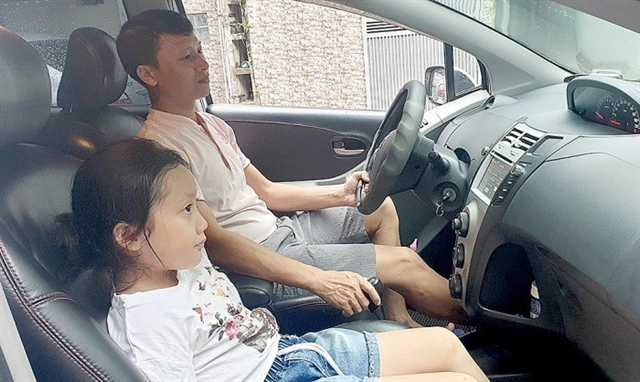 Society
Society


|
| The draft Law on Traffic Safety stipulates that children under 10 years old or those under 135 metres in height are prohibited from occupying the front seat alongside the driver during road traffic. Photo baogiaothong.vn |
HÀ NỘI — Việt Nam currently lacks regulations on the use of safety equipment for children in cars, Head of the Office of the National Traffic Safety Committee Trần Hữu Minh has said.
He emphasised the urgency of addressing this legal gap by finalising provisions in the ongoing drafts of the Law on Road Traffic and the Law on Road Traffic Order and Safety to provide better protection for children.
The Ministry of Public Security is collecting opinions on the draft Law on Road Traffic and Law on Road Traffic Order and Safety Traffic Safety. According to the proposed legislation, children under four years old must be secured in specially designed seats. Additionally, children under 10 years old or those under 135m in height are prohibited from occupying the front seat alongside the driver during road traffic. Furthermore, passenger vehicles with a capacity of up to nine seats must include guidelines for installing child seats and safety belts.
Many serious traffic accidents have occurred due to children not wearing seat belts or not having suitable safety equipment. On July 14, 2023, a five-seated car travelling from Nam Định City to Hợp Hưng Commune collided with a truck at the intersection of Vụ Bản District. At that time, there were four people in the car, including two women and two girls. The collision resulted in the death of the female driver and one child.
On February 24, 2021, in Lâm Đồng Province, a seven-seated car collided head-on with a concrete guardrail while descending. The accident injured four people in the family, who were rushed to Lâm Đồng No 2 Hospital for emergency treatment. However, due to severe injuries, a 7-year-old child died on the way to the hospital.
Traffic safety experts say many of these damages can be prevented if children are protected by appropriate safety equipment.
According to preliminary assessments by the National Traffic Safety Committee, there are approximately 1,800-2,000 traffic accidents involving children each year, with around 600-700 accidents involving children in cars.
Citing findings from 1,102 private cars and 1,457 children aged 0 to 10 in three major cities in Hà Nội, Đà Nẵng and HCM City, Dương Kim Tuấn from the University of Public Health reported that over 42 per cent of parents allowed their children to sit in the front seat, with 19.2 per cent of them being held by adults on the front seat.
The use of safety equipment was very low across all three cities, ranging from only 1.3 per cent to a high of 2.6 per cent in Hà Nội. In Đà Nẵng, the rate was a mere 0.4 per cent.
Regarding the safest seating position for children in cars, 36 per cent responded that sitting in the back seat was the safest, 28 per cent believed sitting in the front seat was safest, and 27.8 per cent considered using specialised safety equipment to be the best option.
A significant 75.4 per cent supported the necessity of mandatory regulations regarding safety equipment in vehicles.
“In the rapidly increasing trend of car usage in Việt Nam, especially among young families, regulations regarding safety equipment are extremely crucial to ensure children's safety in traffic,” he said.
Dr Phạm Việt Cường, director of the Centre for Injury Policy and Prevention Research at the University of Public Health, stated that seat belts in cars reduce serious injuries by 70 per cent and decrease the likelihood of death by 40 per cent for passengers. However, seat belts are designed for adults and may not effectively restrain children in the event of a collision.
Cường advocated for mandatory requirements for using car seats for children, recommending their application for children up to 10 years old or shorter than 135cm. Children under 12 should not sit in the front seats of cars.
“Enhanced monitoring and penalties for failure to use car seats for children should be implemented," he said.
Nearly 100 countries have legislated mandatory regulations for using child safety devices in private cars.
If regulations on the use of child safety equipment are effectively implemented, it could potentially reduce up to 400-500 cases of severely injured or deceased children in cars per year in Việt Nam.
Experts suggested that these regulations should only apply to private cars, as they are the type of vehicles that can travel at high speeds on highways, with a high frequency of usage for children, and parents or guardians are aware of this need in advance.
Encouragement should be given for public transport vehicles because they operate at lower speeds, within urban areas, have higher safety standards, and face difficulties in meeting random child transportation needs. — VNS




